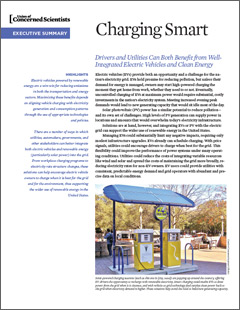Everyone loves electric cars—they’re clean, fun to drive, and increasingly affordable to own. But what do electric vehicles (EVs) mean for the electricity grid? Could they enable the use of more renewable power?
Following a literature review, modeling, and conversations with the field’s leading experts, the Union of Concerned Scientists has identified a number of smart charging conclusions and recommendations. We’ve found a number of ways that states, utilities, automakers, and charging providers can better integrate EVs and renewable energy into the grid—with significant environmental and economic savings.
Download the executive summary or full report for more details, or read below for a summary.
Matching supply and demand
The fundamental issue is the impact of EV charging on electricity supply and demand. Left unmanaged, EV owners may simply charge their cars when they return from work, producing spikes in electricity demand at the worst possible time (electricity use already peaks in the evening).
This could in turn require companies to build costly new power plants that sit unused most of the day.
But by coordinating EV charging with periods of cheap and abundant power, utilities can actually match supply and demand. In some areas this may mean charging cars in the middle of the day, when solar panels are most productive; in others, optimal charging may occur in the middle of the night, powered by the wind.
An even more advanced and flexible arrangement, known as “vehicle to grid,” would allow two-way energy transfers between car batteries and the grid they’re plugged into.
These and other “smart charging” strategies can cut emissions, lower electricity rates, and provide a helpful new suite of grid services.
Smart charging solutions
Below are some of our top-line conclusions on the future of smart charging:
- Smart charging is viable. Numerous pilot projects have illustrated the real-life benefits of managed EV charging.
- Drivers should take priority. Drivers shouldn’t find their vehicles uncharged when they need them. This concern is lessened as more EVs are deployed.
- Time-of-use pricing is a good near-term option. Pricing electricity based on supply and demand can help avoid costly peak hour charging. Read more here.
- Smart charging offers ancillary services. EVs can offer valuable storage and “flexible load” services to grid operators.
- Utilities need a data plan. EVs and EV chargers can collect helpful new data for the grid—but utilities will need to know how to use it.




